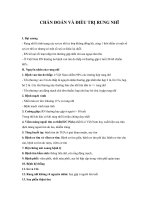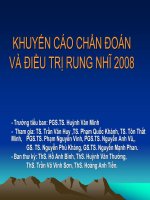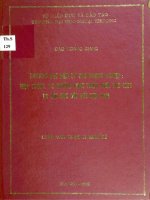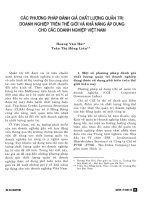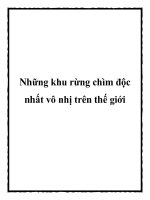Xử trí rung nhĩ trên 48 giờ
Bạn đang xem bản rút gọn của tài liệu. Xem và tải ngay bản đầy đủ của tài liệu tại đây (661.6 KB, 25 trang )
XỬ TRÍ RUNG NHĨ TRÊN 48 GiỜ:
AI NÊN CHUYỂN NHỊP?
KHI NÀO? NHƯ THẾ NÀO?
BS BÙI THẾ DŨNG
BV ĐẠI HỌC Y DƯỢC TP. HCM
PHÂN LOẠI RUNG NHĨ
2014 AHA/ACC/HRS Atrial Fibrillation Guideline
ĐIỀU TRỊ RUNG NHĨ
KIỂM SOÁT
TẦN SỐ
KIỂM SOÁT
NHỊP
ĐIỀU TRỊ
BỆNH LIÊN
QUAN
NGỪA
HUYẾT KHỐI
Rate vs Rhythm Control Trials for AF
Heist et al. Rate Control in Atrial Fibrillation: Targets, Methods, Resynchronization
Considerations. Circulation. 2011;124:2746-2755
CHUYỂN NHỊP RUNG NHĨ > 48H
1.
2.
3.
4.
•
•
•
Tại sao cần kiểm soát nhịp
Đối tượng cần kiểm soát nhịp
Chuẩn bị bệnh nhân cần chuyển nhịp
Các phương thức kiểm soát nhịp
Shock điện
Thuốc
Cắt đốt qua catheter
LỢI ÍCH CHUYỂN NHỊP RUNG NHĨ
•
•
•
•
Cải thiện triệu chứng, tăng khả năng gắng sức
Cải thiện chất lượng sống
Giảm nguy cơ đột quỵ
Tránh tai biến do dùng thuốc kháng đông kéo
dài
European Heart Journal (2010) 31, 2369-2429
AI CẦN CHUYỂN NHỊP?
•
•
•
•
•
•
•
Rung nhĩ gây rối loạn huyết động
Khó kiểm soát tần số thất
Trẻ tuổi
Bệnh cơ tim do nhịp nhanh
Cơn rung nhĩ đầu tiên
Rung nhĩ do 1 bệnh lý cấp tính thúc đẩy
Chọn lựa của bệnh nhân
2014 AHA/ACC/HRS Atrial Fibrillation Guideline
Canadian Journal of Cardiology 2014 30, 1114-1130
DỰ PHÒNG HUYẾT KHỐI LẤP MẠCH
• Sau chuyển nhịp, tỷ lệ lấp mạch ở BN không dùng
warfarin là 5.3%, có dùng warfarin là 0.8% [1,2]
• Tỷ lệ lấp mạch sau chuyển nhịp rung nhĩ mới xuất hiện
< 48h là 1% [3]
→ Đối với rung nhĩ ≥ 48h hoặc không rõ thời gian
khởi phát, cần dùng kháng đông uống (warfarin/
NOACs) trước chuyển nhịp ≥ 3 tuần [4]
1.
2.
3.
4.
Boston Area Anticoagulation Trial for AF Investigators The effect of low dose warfarin on the risk of
stroke in patients with nonrheumatic AF. N Engl J Med. 1990;323:1505–11
Bjerkelund C. The efficacy of anticoagulant therapy in preventing embolism related to DC electrical
cardioversion of atrial fibrillation. Am J Cardiol. 1969;23:208–16
Weigner WJ. Risk for clinical thromboembolism associated with conversion to sinus rhythm in patients
with AFlasting less than 48 hours. Ann Intern Med. 1997;126:615–20
2014 AHA/ACC/HRS Atrial Fibrillation Guideline
DỰ PHÒNG HUYẾT KHỐI LẤP MẠCH
• TEE có thể thay thế cho việc dùng kháng đông
3 tuần trước chuyển nhịp
• Kháng đông nên được dùng càng sớm càng tốt
nếu cần chuyển nhịp cấp cứu
• Dùng kháng đông đường uống ≥ 4 tuần sau
chuyển nhịp, bất kể điểm CHADS-VAS
2014 AHA/ACC/HRS Atrial Fibrillation Guideline
Prevention of Thromboembolism
Recommendations
For patients with AF or atrial flutter of 48 hours’ duration or longer, or
when the duration of AF is unknown, anticoagulation with warfarin (INR
2.0 to 3.0) is recommended for at least 3 weeks before and 4 weeks after
cardioversion, regardless of the CHA2DS2-VASc score and the method
(electrical or pharmacological) used to restore sinus rhythm.
COR
LOE
I
B
For patients with AF or atrial flutter of more than 48 hours’ duration or
unknown duration that requires immediate cardioversion for
hemodynamic instability, anticoagulation should be initiated as soon as
possible and continued for at least 4 weeks after cardioversion unless
contraindicated.
I
C
For patients with AF or atrial flutter of less than 48 hours’ duration and
with high risk of stroke, intravenous heparin or LMWH, or
administration of a factor Xa or direct thrombin inhibitor, is
recommended as soon as possible before or immediately after
cardioversion, followed by long-term anticoagulation therapy.
I
C
2014 AHA/ACC/HRS Atrial Fibrillation Guideline
Prevention of Thromboembolism (cont’d)
Recommendations
Following cardioversion for AF of any duration, the decision
about long-term anticoagulation therapy should be based on the
thromboembolic risk profile.
For patients with AF or atrial flutter of 48 hours’ duration or
longer or of unknown duration who have not been anticoagulated
for the preceding 3 weeks, it is reasonable to perform TEE before
cardioversion and proceed with cardioversion if no LA thrombus
is identified, including in the LAA, provided that anticoagulation
is achieved before TEE and maintained after cardioversion for at
least 4 weeks.
For patients with AF or atrial flutter of 48 hours’ duration or
longer or when duration of AF is unknown, anticoagulation with
dabigatran, rivaroxaban, or apixaban is reasonable for at least 3
weeks before and 4 weeks after cardioversion.
COR
LOE
I
C
IIa
B
IIa
C
2014 AHA/ACC/HRS Atrial Fibrillation Guideline
Kháng đông trước – sau chuyển nhịp
Canadian Journal of Cardiology 2014 30, 1114-1130
Direct-Current Cardioversion
Recommendations
COR
In pursuing a rhythm-control strategy, cardioversion is
recommended for patients with AF or atrial flutter as a method to
restore sinus rhythm. If cardioversion is unsuccessful, repeated
attempts at direct-current cardioversion may be made after
I
adjusting the location of the electrodes, applying pressure over the
electrodes or following administration of an antiarrhythmic
medication.
Cardioversion is recommended when a rapid ventricular response
to AF or atrial flutter does not respond promptly to
I
pharmacological therapies and contributes to ongoing myocardial
ischemia, hypotension, or HF.
Cardioversion is recommended for patients with AF or atrial
flutter and pre-excitation when tachycardia is associated with
I
hemodynamic instability.
2014 AHA/ACC/HRS Atrial Fibrillation Guideline
LOE
B
C
C
Pharmacological Cardioversion
Recommendations
Flecainide, dofetilide, propafenone, and intravenous ibutilide are
useful for pharmacological cardioversion of AF or atrial flutter,
provided contraindications to the selected drug are absent.
Administration of oral amiodarone is a reasonable option for
pharmacological cardioversion of AF.
Propafenone or flecainide (“pill-in-the-pocket”) in addition to a
beta blocker or nondihydropyridine calcium channel antagonist is
reasonable to terminate AF outside the hospital once this
treatment has been observed to be safe in a monitored setting for
selected patients.
Dofetilide therapy should not be initiated out of hospital because
of the risk of excessive QT prolongation that can cause torsades
de pointes.
COR
LOE
I
A
IIa
A
IIa
B
III:
Harm
B
2014 AHA/ACC/HRS Atrial Fibrillation Guideline
Antiarrhythmic Drugs to Maintain Sinus Rhythm
Recommendations
Before initiating antiarrhythmic drug therapy, treatment of
precipitating or reversible causes of AF is recommended.
The following antiarrhythmic drugs are recommended in patients
with AF to maintain sinus rhythm, depending on underlying heart
disease and comorbidities:
a. Amiodarone
b. Dofetilide
c. Dronedarone
d. Flecainide
e. Propafenone
f. Sotalol
The risks of the antiarrhythmic drug, including proarrhythmia,
should be considered before initiating therapy with each drug.
COR
LOE
I
C
I
A
I
C
2014 AHA/ACC/HRS Atrial Fibrillation Guideline
Antiarrhythmic Drugs to Maintain Sinus Rhythm
(cont’d)
Recommendations
Because of its potential toxicities, amiodarone should only be
used after consideration of risks and when other agents have failed
or are contraindicated.
A rhythm-control strategy with pharmacological therapy can be
useful in patients with AF for the treatment of tachycardiainduced cardiomyopathy.
It may be reasonable to continue current antiarrhythmic drug
therapy in the setting of infrequent, well-tolerated recurrences of
AF when the drug has reduced the frequency or symptoms of AF.
Antiarrhythmic drugs for rhythm control should not be continued
when AF becomes permanent,…
…including dronedarone.
COR
LOE
I
C
IIa
C
IIb
C
III:
Harm
2014 AHA/ACC/HRS Atrial Fibrillation Guideline
C
B
Upstream Therapy
Recommendations
An ACE inhibitor or angiotensin-receptor blocker is reasonable
for primary prevention of new-onset AF in patients with HF with
reduced LVEF.
Therapy with an ACE inhibitor or ARB may be considered for
primary prevention of new-onset AF in the setting of
hypertension.
Statin therapy may be reasonable for primary prevention of newonset AF after coronary artery surgery.
Therapy with an ACE inhibitor, ARB, or statin is not beneficial
for primary prevention of AF in patients without cardiovascular
disease.
COR
LOE
IIa
B
IIb
B
IIb
A
III: No
Benefit
B
2014 AHA/ACC/HRS Atrial Fibrillation Guideline
Cắt đốt qua catheter: phân tích gộp
Ablation method
Patients Paroxysmal AF
SHD
6-month cure 6-months OK
Linear
443
75%
26%
33%
55%
Focal
508
81%
35%
54%
71%
Isolation
2,187
83%
36%
62%
75%
Circumferential (all)
15,455
68%
37%
64%
74%
Circumferential
(LACA, WACA)
2,449
65%
37%
59%
72%
Circumferential
(PVAI)
11,132
68%
42%
67%
76%
559
51%
49%
75%
87%
23,626
61%
55%
63%
75%
Substrate ablation
(CFAE)
TOTAL
Cure (by each author’s criteria) means no further AFib 6 months after the procedure in the absence of
AAD.
OK means improvement (fewer episodes, no episodes with previously ineffective AAD).
SHD indicates structural heart disease.
Fisher JD, et al. PACE 2006;29: 523
19
Bệnh nhân không còn rung nhĩ sau cắt
đốt so với thuốc
Khả năng sống còn không còn rung nhĩ
(%)
100
84%
79%
80
78%
61%
P < 0,001
60
47%
Nhóm cắt đốt (n=589)
37%
40
Nhóm thuốc (n=582)
20
0
0
6
12
18
24
30
36
Theo dõi (tháng)
Pappone C, et al. J Am Coll Cardiol 2003 Jul 16;42(2):185-97
20
Cải thiện sống còn bằng cắt đốt so với thuốc
589 BN rung nhĩ có triệu chứng được cắt đốt so với
582 điều trị thuốc
Nhóm cắt đốt
Nhóm điều trị thuốc
Khả năng sống còn (%)
100
90
Chờ đợi
Quan sát
80
70
60
One-sample log-rank test
Obs=36, Exp=31, Z=0.597, p=0.55
One-sample log-rank test
Obs=79, Exp=341, Z=7.07, p<0.001
0
0
180
360
540
720
Ngày theo dõi
900
1080 0
180
360
540
720
900
1080
Ngày theo dõi
Pappone C, et al. J Am Coll Cardiol 2003 Jul 16;42(2):185-97
21
Cân nhắc Lợi ích-Nguy cơ cắt đốt
Canadian Journal of Cardiology 2014 30, 1114-1130
AF Catheter Ablation to Maintain Sinus Rhythm
Recommendations
AF catheter ablation is useful for symptomatic paroxysmal AF
refractory or intolerant to at least 1 class I or III antiarrhythmic
medication when a rhythm-control strategy is desired.
Before consideration of AF catheter ablation, assessment of the
procedural risks and outcomes relevant to the individual patient is
recommended.
AF catheter ablation is reasonable for some patients with
symptomatic persistent AF refractory or intolerant to at least 1
class I or III antiarrhythmic medication.
In patients with recurrent symptomatic paroxysmal AF, catheter
ablation is a reasonable initial rhythm-control strategy before
therapeutic trials of antiarrhythmic drug therapy, after weighing
the risks and outcomes of drug and ablation therapy.
COR
LOE
I
A
I
C
IIa
A
IIa
B
2014 AHA/ACC/HRS Atrial Fibrillation Guideline
Chiến lược kiểm soát nhịp trong rung nhĩ
kịch phát và dai dẳng
Không có bệnh tim
cấu trúc
Có bệnh tim cấu trúc
Bệnh mạch vành
Dofetilide
Dronedatone
Flecaine
Propafenone
Sotalol
Amidarone
Cắt đốt
Dofetilide
Dronedarone
Sotalol
Cắt đốt
Suy tim
Amidarone
Dofetilide
Amidarone
January, CT et al. 2014 AHA/ACC/HRS Atrial Fibrillation Guideline
24
KẾT LUẬN
• Chuyển nhịp RN giúp cải thiện triệu chứng, và
nên thực hiện ở một số đối tượng thích hợp
• RN xuất hiện trên 48h: cần kháng đông trước
chuyển nhịp 3 tuần và sau chuyển nhịp 4 tuần
để giảm thiểu biến cố lấp mạch
• Shock điện là phương tiện chuyển nhịp tức
thời hiệu quả nhất
• Cắt đốt so với thuốc: hiệu quả tức thời và lâu
dài cao hơn, cải thiện tỷ lệ sống còn tốt hơn

